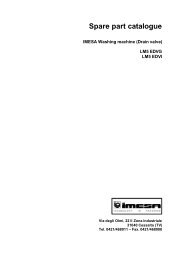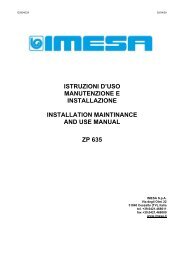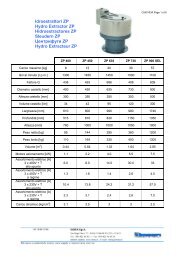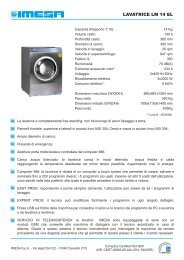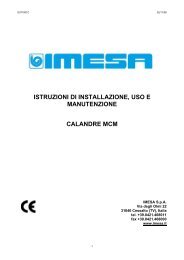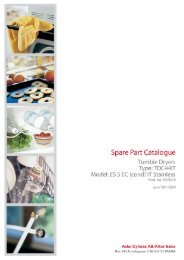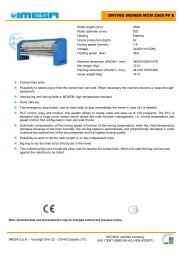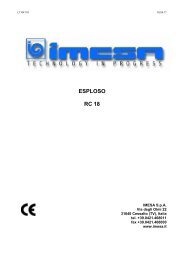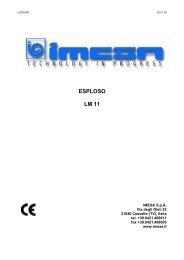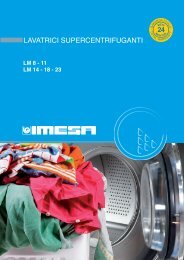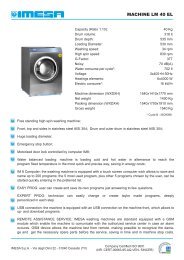S/EP1 - S/EP3 S/EP4 - S/EP5 - IMESA SpA
S/EP1 - S/EP3 S/EP4 - S/EP5 - IMESA SpA
S/EP1 - S/EP3 S/EP4 - S/EP5 - IMESA SpA
You also want an ePaper? Increase the reach of your titles
YUMPU automatically turns print PDFs into web optimized ePapers that Google loves.
15<br />
• Steaming on bottom buck by means of pedal (ref.4).<br />
• Vacuum on bottom buck by means of pedal (ref.3).<br />
5.6 MACHINE SUPPLIED WITH TIMERS (tav.01)<br />
On request, the machine can be equipped with timers<br />
which establish the length of time required for the<br />
principal work phases.<br />
In this case, act as follows:<br />
• Put the switch (ref.18) on the automatic position.<br />
• Establish working time required (15-20” for phase)<br />
on the timers: steaming time (ref.16), vacuum time<br />
(ref.15), pressing and closing time (ref.17).<br />
• Once the garment to be pressed has been<br />
positioned on the bottom buck, the automatic cycle<br />
is started, by closing the top buck, either by means<br />
of the two push buttons (tav.07 fig.A-ref.1 and 2) or<br />
by means of the pedal (tav.07 fig.B-ref.1) or by<br />
means of the two push buttons (tav.07 fig.C-ref.1<br />
and 7).<br />
• The press automatically closed the top buck,<br />
steams on the lower buck, provides vacuum and<br />
then re-opens the top buck.<br />
5.7 PRESS WITH POLISHED TOP BUCK<br />
On request and for special uses like the pressing of<br />
garments in linen and cotton, it is possible to supply the<br />
press with a polished top buck, only steam heated.<br />
Naturally all the different options available on the<br />
standard press stay the same.<br />
5.8 ADJUSTMENTS DURING USE<br />
• To block the top buck and use only the bottom<br />
buck as a steaming and vacuum table, use the<br />
device (tav.01-ref.11).<br />
• To vary the closing pressure of the bucks, use the<br />
knob (tav.01-ref.10), turning clockwise to increase<br />
pressure and anti-clockwise to reduce it.<br />
5.9 END OF DAILY OPERATION<br />
At the end of the working day, remember to do the<br />
following:<br />
• close the water supply;<br />
• shut off the compressed air supply;<br />
• disconnect the machine by putting the main switch<br />
(tav.01-ref.1) on the “O” position.<br />
6 MAINTENANCE<br />
6.1 MAINTENANCE CONDITIONS<br />
Ordinary and extraordinary maintenance must always<br />
be carried out in safe conditions.<br />
For maintenance which does not require the machine<br />
to be active, the following instructions must be<br />
complied with:<br />
• put the main switch (tav.01-ref.1) on the “O”<br />
position;<br />
• block the switch in this position by means of a<br />
lock, making use of the existing holes;<br />
• always carry the lock key on your person, above<br />
all when the back of the machine is being worked<br />
on.<br />
If it is necessary to put the machine temporarily out of<br />
order, then it must be fully disconnected from the main<br />
supply.<br />
6.2 SAFETY MEASURES TO BE ADOPTED IN<br />
MAINTENANCE<br />
It should be remembered that pressure remains in the<br />
compressed air and steam systems even when the<br />
machine has stopped; therefore any intervention must be<br />
preceded by the discharging of any remaining pressure.<br />
It should also be remembered that all parts in contact<br />
with steam stay hot even after the machine has stopped;<br />
therefore prior to any intervention it is necessary to<br />
check that the hot surfaces have cooled down.<br />
6.3 PNEUMATIC CIRCUIT<br />
At least every two days, check that there is enough oil in<br />
the lubricator cup (tav.03-ref.28) and if necessary refill<br />
with suitable oil (ISO-UNI HG 32 class H-CASTROL<br />
MAGNA GC 32 or equivalent).<br />
Once a day, discharge the condensate deposited in the<br />
air filter cup (tav.03-ref.26).<br />
6.4 PIPES AND CONNECTIONS<br />
Periodically check that all connections are tightly clamped<br />
and that pipes in general do not leak air or steam.<br />
6.5 WATER FILTER<br />
It is raccomended that the water inlet filter (tav.20-ref.4)<br />
be cleaned once a month and if necessary replaced.<br />
6.6 PADDING (Tav.18-19)<br />
Vacuum action depends on the passage of air through<br />
the buck padding.<br />
Therefore, every six months or so, when a drop in<br />
vacuum action is observed, the covering should be<br />
replaced.<br />
6.7 CLEANING OF THE BOILER<br />
The boiler should be cleaned every six months.<br />
To carry out this operation dismantle the element (tav.<br />
20-ref.13), remove all the calcareous deposits from the<br />
boiler body and above all the elements.<br />
Check that the boiler drain hole is not obstructed and if<br />
necessary put this right.<br />
6.8 CLEANING OF THE LEVEL PROBE<br />
For the correct operation of the machine, it is strongly<br />
recommended to check the condition of the level probe<br />
(tav.20-rif.05) every six months.<br />
If it should prove to be clean, in future allow a longer<br />
period of time before checking again.<br />
In order to carry out this operation, remove the front<br />
door (tav.17-rif.18) and then fully unscrew the probe<br />
screw using a CH19 spanner and extract the probe rod.<br />
6.9 BOILER DRAIN<br />
It is advisable to empty water out of the boiler every<br />
week.<br />
Wait for the steam pressure on the pressure gauge to<br />
descend to at least 0,5 bar and then open the drain tap<br />
(tav.02-ref.22).



